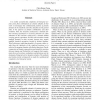Free Online Productivity Tools
i2Speak
i2Symbol
i2OCR
iTex2Img
iWeb2Print
iWeb2Shot
i2Type
iPdf2Split
iPdf2Merge
i2Bopomofo
i2Arabic
i2Style
i2Image
i2PDF
iLatex2Rtf
Sci2ools
BMEI
2009
IEEE
2009
IEEE
Analysis of the Bipartite Networks of Domain Compositions and Metabolic Reactions
It is widely accepted that complexity of biological systems arises from combinations of common subunits. In this work we investigate the combinatorial patterns of protein domains in the metabolic networks and find several general rules in the patterns of domain combinations and their evolution. First, the reactions catalyzed by a domain subunit carrying specialized or accessory functions are often subsumed to the reactions catalyzed by a domain subunit carrying generic operations. Second, some reactions contain multiple domains in their enzymes because they require multiple chemical operations carried by distinct domains. Third, pleiotropy (multi-functionality) of enzymes either results from the similarity of the catalyzed reactions or is achieved by merging domains with distinct functions. Fourth, comparison of domain compositions and metabolic reactions between human and Escherichia coli suggests that requirements for novel reactions, redundancy and pleiotropy are the dominant drivi...
| Added | 08 Nov 2010 |
| Updated | 08 Nov 2010 |
| Type | Conference |
| Year | 2009 |
| Where | BMEI |
| Authors | Chen-Hsiang Yeang |
Comments (0)

